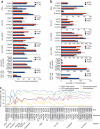Comprehensive assessment of array-based platforms and calling algorithms for detection of copy number variants
- PMID: 21552272
- PMCID: PMC3270583
- DOI: 10.1038/nbt.1852
Comprehensive assessment of array-based platforms and calling algorithms for detection of copy number variants
Abstract
We have systematically compared copy number variant (CNV) detection on eleven microarrays to evaluate data quality and CNV calling, reproducibility, concordance across array platforms and laboratory sites, breakpoint accuracy and analysis tool variability. Different analytic tools applied to the same raw data typically yield CNV calls with <50% concordance. Moreover, reproducibility in replicate experiments is <70% for most platforms. Nevertheless, these findings should not preclude detection of large CNVs for clinical diagnostic purposes because large CNVs with poor reproducibility are found primarily in complex genomic regions and would typically be removed by standard clinical data curation. The striking differences between CNV calls from different platforms and analytic tools highlight the importance of careful assessment of experimental design in discovery and association studies and of strict data curation and filtering in diagnostics. The CNV resource presented here allows independent data evaluation and provides a means to benchmark new algorithms.
Figures




Similar articles
-
Evaluation of copy number variation detection for a SNP array platform.BMC Bioinformatics. 2014 Feb 21;15:50. doi: 10.1186/1471-2105-15-50. BMC Bioinformatics. 2014. PMID: 24555668 Free PMC article.
-
Comprehensive performance comparison of high-resolution array platforms for genome-wide Copy Number Variation (CNV) analysis in humans.BMC Genomics. 2017 Apr 24;18(1):321. doi: 10.1186/s12864-017-3658-x. BMC Genomics. 2017. PMID: 28438122 Free PMC article.
-
CNV Workshop: an integrated platform for high-throughput copy number variation discovery and clinical diagnostics.BMC Bioinformatics. 2010 Feb 4;11:74. doi: 10.1186/1471-2105-11-74. BMC Bioinformatics. 2010. PMID: 20132550 Free PMC article.
-
Comparative Analysis of CNV Calling Algorithms: Literature Survey and a Case Study Using Bovine High-Density SNP Data.Microarrays (Basel). 2013 Jun 25;2(3):171-85. doi: 10.3390/microarrays2030171. Microarrays (Basel). 2013. PMID: 27605188 Free PMC article. Review.
-
Current analysis platforms and methods for detecting copy number variation.Physiol Genomics. 2013 Jan 7;45(1):1-16. doi: 10.1152/physiolgenomics.00082.2012. Epub 2012 Nov 6. Physiol Genomics. 2013. PMID: 23132758 Free PMC article. Review.
Cited by
-
GStream: improving SNP and CNV coverage on genome-wide association studies.PLoS One. 2013 Jul 3;8(7):e68822. doi: 10.1371/journal.pone.0068822. Print 2013. PLoS One. 2013. PMID: 23844243 Free PMC article.
-
Haplotype phasing and inheritance of copy number variants in nuclear families.PLoS One. 2015 Apr 8;10(4):e0122713. doi: 10.1371/journal.pone.0122713. eCollection 2015. PLoS One. 2015. PMID: 25853576 Free PMC article.
-
Extensive load of somatic CNVs in the human placenta.Sci Rep. 2015 Feb 10;5:8342. doi: 10.1038/srep08342. Sci Rep. 2015. PMID: 25666259 Free PMC article. Clinical Trial.
-
Rare deletions at the neurexin 3 locus in autism spectrum disorder.Am J Hum Genet. 2012 Jan 13;90(1):133-41. doi: 10.1016/j.ajhg.2011.11.025. Epub 2011 Dec 29. Am J Hum Genet. 2012. PMID: 22209245 Free PMC article.
-
Genome-wide identification of copy number variation and association with fat deposition in thin and fat-tailed sheep breeds.Sci Rep. 2022 May 25;12(1):8834. doi: 10.1038/s41598-022-12778-1. Sci Rep. 2022. PMID: 35614300 Free PMC article.
References
-
- Iafrate AJ, et al. Detection of large-scale variation in the human genome. Nat. Genet. 2004;36:949–951. - PubMed
-
- Sebat J, et al. Large-scale copy number polymorphism in the human genome. Science. 2004;305:525–528. - PubMed
-
- Tuzun E, et al. Fine-scale structural variation of the human genome. Nat. Genet. 2005;37:727–732. - PubMed
-
- Zhang J, Feuk L, Duggan GE, Khaja R, Scherer SW. Development of bioinformatics resources for display and analysis of copy number and other structural variants in the human genome. Cytogenet. Genome Res. 2006;115:205–214. - PubMed
Publication types
MeSH terms
Associated data
- Actions
Grants and funding
- 213997/CAPMC/ CIHR/Canada
- 077008/WT_/Wellcome Trust/United Kingdom
- T32 HD007396/HD/NICHD NIH HHS/United States
- R01 HD055150/HD/NICHD NIH HHS/United States
- HG004221/HG/NHGRI NIH HHS/United States
- HD055150/HD/NICHD NIH HHS/United States
- 077014/WT_/Wellcome Trust/United Kingdom
- P01 HD068250/HD/NICHD NIH HHS/United States
- HD007396/HD/NICHD NIH HHS/United States
- U01 HG005209/HG/NHGRI NIH HHS/United States
- CA111560/CA/NCI NIH HHS/United States
- HG005209/HG/NHGRI NIH HHS/United States
- R01 CA111560/CA/NCI NIH HHS/United States
- P41 HG004221/HG/NHGRI NIH HHS/United States
- T32 GM007748/GM/NIGMS NIH HHS/United States
LinkOut - more resources
Full Text Sources
Other Literature Sources
Molecular Biology Databases
Research Materials

